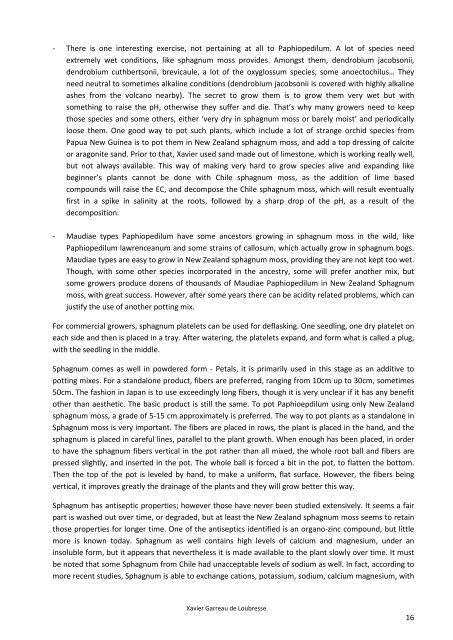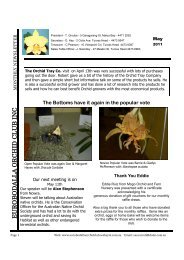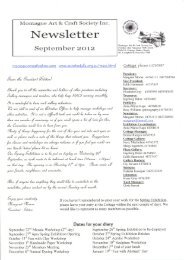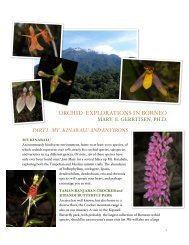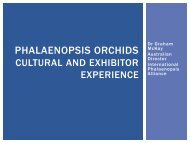Orchid Growing Substrates
Orchid Growing Substrates
Orchid Growing Substrates
Create successful ePaper yourself
Turn your PDF publications into a flip-book with our unique Google optimized e-Paper software.
- There is one interesting exercise, not pertaining at all to Paphiopedilum. A lot of species need<br />
extremely wet conditions, like sphagnum moss provides. Amongst them, dendrobium jacobsonii,<br />
dendrobium cuthbertsonii, brevicaule, a lot of the oxyglossum species, some anoectochilus… They<br />
need neutral to sometimes alkaline conditions (dendrobium jacobsonii is covered with highly alkaline<br />
ashes from the volcano nearby). The secret to grow them is to grow them very wet but with<br />
something to raise the pH, otherwise they suffer and die. That’s why many growers need to keep<br />
those species and some others, either ‘very dry in sphagnum moss or barely moist’ and periodically<br />
loose them. One good way to pot such plants, which include a lot of strange orchid species from<br />
Papua New Guinea is to pot them in New Zealand sphagnum moss, and add a top dressing of calcite<br />
or aragonite sand. Prior to that, Xavier used sand made out of limestone, which is working really well,<br />
but not always available. This way of making very hard to grow species alive and expanding like<br />
beginner’s plants cannot be done with Chile sphagnum moss, as the addition of lime based<br />
compounds will raise the EC, and decompose the Chile sphagnum moss, which will result eventually<br />
first in a spike in salinity at the roots, followed by a sharp drop of the pH, as a result of the<br />
decomposition.<br />
- Maudiae types Paphiopedilum have some ancestors growing in sphagnum moss in the wild, like<br />
Paphiopedilum lawrenceanum and some strains of callosum, which actually grow in sphagnum bogs.<br />
Maudiae types are easy to grow in New Zealand sphagnum moss, providing they are not kept too wet.<br />
Though, with some other species incorporated in the ancestry, some will prefer another mix, but<br />
some growers produce dozens of thousands of Maudiae Paphiopedilum in New Zealand Sphagnum<br />
moss, with great success. However, after some years there can be acidity related problems, which can<br />
justify the use of another potting mix.<br />
For commercial growers, sphagnum platelets can be used for deflasking. One seedling, one dry platelet on<br />
each side and then is placed in a tray. After watering, the platelets expand, and form what is called a plug,<br />
with the seedling in the middle.<br />
Sphagnum comes as well in powdered form - Petals, it is primarily used in this stage as an additive to<br />
potting mixes. For a standalone product, fibers are preferred, ranging from 10cm up to 30cm, sometimes<br />
50cm. The fashion in Japan is to use exceedingly long fibers, though it is very unclear if it has any benefit<br />
other than aesthetic. The basic product is still the same. To pot Paphioepdilum using only New Zealand<br />
sphagnum moss, a grade of 5-15 cm approximately is preferred. The way to pot plants as a standalone in<br />
Sphagnum moss is very important. The fibers are placed in rows, the plant is placed in the hand, and the<br />
sphagnum is placed in careful lines, parallel to the plant growth. When enough has been placed, in order<br />
to have the sphagnum fibers vertical in the pot rather than all mixed, the whole root ball and fibers are<br />
pressed slightly, and inserted in the pot. The whole ball is forced a bit in the pot, to flatten the bottom.<br />
Then the top of the pot is leveled by hand, to make a uniform, flat surface. However, the fibers being<br />
vertical, it improves greatly the drainage of the plants and they will grow better this way.<br />
Sphagnum has antiseptic properties; however those have never been studied extensively. It seems a fair<br />
part is washed out over time, or degraded, but at least the New Zealand sphagnum moss seems to retain<br />
those properties for longer time. One of the antiseptics identified is an organo-zinc compound, but little<br />
more is known today. Sphagnum as well contains high levels of calcium and magnesium, under an<br />
insoluble form, but it appears that nevertheless it is made available to the plant slowly over time. It must<br />
be noted that some Sphagnum from Chile had unacceptable levels of sodium as well. In fact, according to<br />
more recent studies, Sphagnum is able to exchange cations, potassium, sodium, calcium magnesium, with<br />
Xavier Garreau de Loubresse<br />
16


